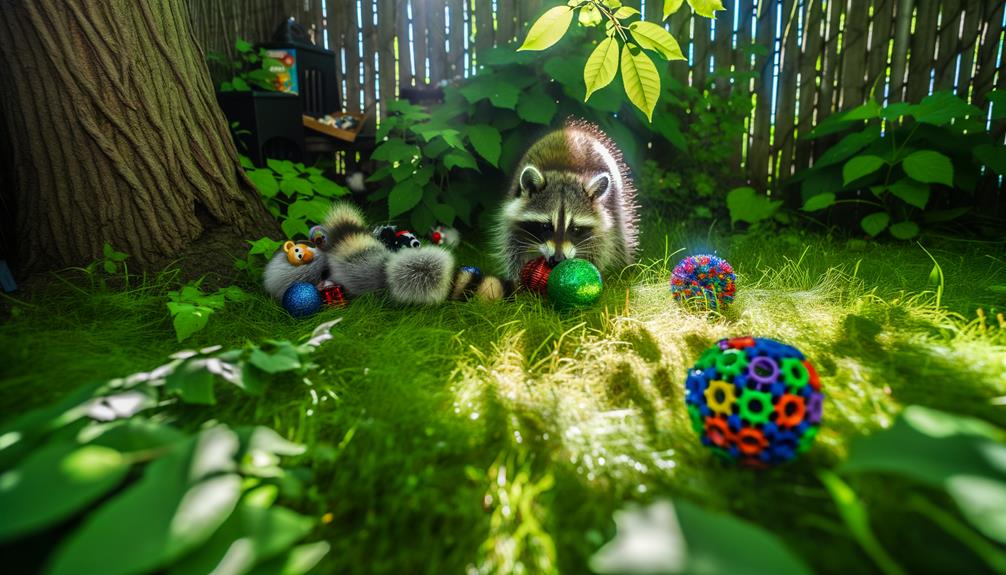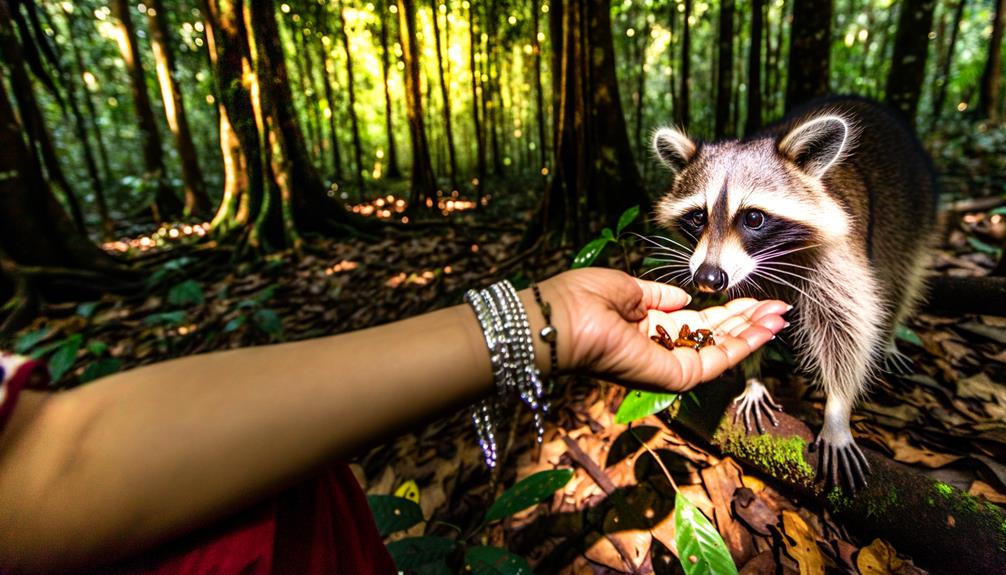Do Raccoons Like Being Given Things?
Raccoons, scientifically known as Procyon lotor, exhibit a keen interest in objects given to them, including food, toys, and shiny items. Their curiosity is driven by their dexterous forepaws and inquisitive nature.
Food offerings can alter their natural foraging patterns and lead to habituation, while toys and shiny objects stimulate cognitive functions and problem-solving abilities. Seasonal gifts further highlight their adaptability and exploration behaviors.
However, human interaction poses risks such as disease transmission and health impacts due to altered diets. Understanding these interactions can enhance wildlife management strategies and offer deeper insights into raccoon behavior.

Key Takeaways
- Raccoons exhibit heightened curiosity and engagement with toys and shiny objects due to their exploratory nature.
- Raccoons enjoy food-based gifts, especially high-calorie items like nuts and fruits, which align with their opportunistic feeding habits.
- Interactive puzzle toys and DIY enrichment activities stimulate raccoons' cognitive functions and problem-solving skills.
- Seasonal gifts, particularly during winter, attract raccoons' interest due to increased food scarcity.
- Raccoons use tactile and olfactory exploration to investigate new objects, showing sustained interest and repeated interaction.
Raccoons and Human Interaction

Raccoons, known scientifically as Procyon lotor, have demonstrated a complex range of behaviors when interacting with humans, influenced by both their natural curiosity and adaptability.
These nocturnal mammals often explore urban environments, showing a remarkable ability to learn and exploit new resources. Their dexterous forepaws allow them to manipulate various objects, making them adept at opening containers and accessing shelter.
While generally wary of direct human contact, raccoons can become habituated to human presence, especially in areas where food sources are abundant. This habituation may lead to increased interactions, ranging from benign curiosity to problematic behaviors such as scavenging in residential areas.
Understanding these interactions is critical for developing effective wildlife management and coexistence strategies.
Food Offerings
Food offerings to raccoons can greatly alter their behavior, influencing their foraging patterns and levels of habituation to human presence. When raccoons are provided with easy access to human food, they may reduce their natural foraging activities, relying instead on these predictable sources. This shift can lead to increased interactions with humans, which can exacerbate habituation and dependency.
Raccoons may become bolder, venturing into residential areas more frequently, which raises concerns about potential conflicts and disease transmission. Scientific observations indicate that a diet high in human-provided food can negatively impact raccoon health, leading to obesity and malnutrition. Thus, while raccoons might willingly accept food offerings, the long-term ecological and health consequences should be carefully considered.
Toys and Playthings

Research on raccoon behavior indicates that interactive puzzle toys and DIY enrichment activities can greatly stimulate their cognitive functions and provide necessary mental engagement.
Studies have shown that raccoons exhibit problem-solving skills when presented with complex toys, suggesting a preference for tasks that challenge their intellect.
Additionally, homemade enrichment activities, such as hiding treats in various objects, can mimic natural foraging behaviors and enhance their overall well-being.
Interactive Puzzle Toys
Interactive puzzle toys serve as an effective method for stimulating raccoons' cognitive abilities and keeping them engaged. These toys challenge raccoons to solve problems and access hidden treats, catering to their natural inquisitiveness and dexterity. By engaging in these activities, raccoons enhance their problem-solving skills and mental acuity, which are critical for survival in the wild.
Research indicates that puzzle toys can reduce stress and prevent stereotypic behaviors, which are repetitive actions often indicative of poor welfare. Moreover, these toys contribute to physical exercise, as raccoons manipulate components to retrieve rewards.
DIY Enrichment Activities
DIY enrichment activities, such as homemade toys and playthings, provide raccoons with opportunities for cognitive stimulation and physical engagement, often using readily available materials to create complex and engaging environments.
Utilizing items like cardboard boxes, PVC pipes, and ropes, these activities can simulate natural foraging behaviors, encouraging raccoons to problem-solve and stay active. For example, hiding treats inside a perforated container prompts raccoons to manipulate the object to extract the reward, thereby enhancing dexterity and mental acuity.
Additionally, puzzle feeders made from simple household items can challenge their intelligence and keep them entertained. These DIY solutions are not only cost-effective but also pivotal in promoting the overall well-being of raccoons in both captive and rehabilitation settings.
Shiny Objects
Raccoons exhibit a marked attraction to shiny objects, driven by their intrinsic curiosity and exploratory behaviors.
This tendency often leads to the collection and hoarding of such items, which may serve as both a cognitive stimulus and a survival strategy.
Understanding this behavior is essential for comprehending the broader aspects of raccoon interaction with their environment and the objects within it.
Attraction to Sparkles
Characterized by an innate curiosity, raccoons exhibit a notable attraction to sparkles and shiny objects, a behavior that is often attributed to their highly developed tactile sensitivity and visual acuity. This proclivity can be understood through various observations:
- Enhanced Vision: Raccoons possess acute vision, particularly in low-light conditions, making shiny objects stand out.
- Tactile Exploration: Their highly sensitive paws allow them to discern detailed textures, enhancing their interest in smooth, reflective surfaces.
- Foraging Instinct: The glimmer of objects may mimic the appearance of water or food sources, triggering investigative behaviors.
- Play Behavior: Interaction with shiny items may serve as enrichment, fulfilling natural play needs.
- Evolutionary Advantage: This attraction could support survival by encouraging exploration of diverse environments.
Understanding these factors provides insight into raccoons' complex behavioral patterns.
Curiosity and Exploration
Exploring their environment with keen curiosity, raccoons are frequently drawn to shiny objects, which serve as both a stimulus for investigation and a source of potential enrichment.
This attraction is attributed to raccoons' highly developed sensory perception, particularly their tactile sense, which compels them to explore novel stimuli. Shiny objects, by reflecting light, capture their attention more readily than other items.
This behavior is observed consistently in both wild and captive raccoons, indicating an intrinsic proclivity towards such stimuli. Studies suggest that the engagement with shiny objects may have adaptive benefits, such as enhancing cognitive function and problem-solving skills.
Providing raccoons with shiny objects can be an effective method to stimulate their natural curiosity and exploratory behaviors.
Collecting and Hoarding
Why do raccoons exhibit a pronounced tendency to collect and hoard shiny objects?
This behavior, often observed in raccoons, can be attributed to several factors rooted in their natural instincts and cognitive abilities.
Raccoons possess a high level of curiosity and dexterity, which drives them to interact with various objects in their environment.
Shiny objects, in particular, attract their attention due to their reflective properties, which stimulate visual interest and engagement.
- Innate curiosity: Raccoons are naturally inquisitive animals.
- Dexterous paws: Their ability to manipulate objects enhances their collecting behavior.
- Visual stimulation: Shiny objects provide visual appeal.
- Survival instincts: Gathering items might be linked to food caching behaviors.
- Cognitive enrichment: Interaction with diverse objects can stimulate their mental faculties.
This multifaceted behavior highlights the complexity of raccoon cognition and instinctual drives.
Seasonal Gifts

Seasonal gifts offer a unique opportunity to observe raccoons' behavioral responses to novel stimuli under varying environmental conditions. During winter, raccoons may show heightened interest in food-based gifts due to increased caloric needs for thermoregulation.
Conversely, in warmer months, non-food items such as toys or nesting materials could elicit more investigatory behaviors. Researchers have noted that raccoons possess dexterous front paws, enabling them to manipulate and explore these seasonal gifts thoroughly.
Studies indicate a correlation between the type of gift and the season, influencing raccoons' engagement levels. Monitoring these interactions provides insights into their adaptability and resourcefulness. Such observations contribute to understanding raccoons' ecological adaptability and their ability to thrive in diverse habitats.
Raccoon Curiosity
Raccoon curiosity manifests in their propensity to investigate novel objects and environments, driven by their innate cognitive and sensory capabilities. This exploration is facilitated by their highly developed tactile senses and dexterous paws, allowing them to manipulate a variety of objects.
Their curiosity is not random but informed by an evolved need to forage and adapt to diverse habitats. Key elements of raccoon curiosity include:
- Tactile exploration: Utilizing their sensitive paws to discern textures and shapes.
- Olfactory investigation: Relying on a keen sense of smell to gather information.
- Visual assessment: Observing changes in their surroundings for potential opportunities.
- Problem-solving: Demonstrating the ability to solve complex tasks for rewards.
- Adaptability: Adjusting behaviors based on past experiences and environmental cues.
This intrinsic curiosity underpins much of their interaction with new stimuli.
Behavioral Responses

When presented with various items, raccoons exhibit a range of behavioral responses that reflect their inherent curiosity and interaction tendencies.
These responses include specific food preferences, which can be observed through their selection and consumption patterns, as well as defensive or aggressive behaviors that may manifest in response to perceived threats.
Understanding these behavioral responses is essential for thoroughly evaluating whether raccoons favor being given things.
Curiosity and Interaction
How do raccoons respond behaviorally when presented with novel objects, and what does this reveal about their curiosity and interaction patterns?
Raccoons exhibit a high degree of curiosity, often engaging in exploratory behaviors when encountering new items. Their interaction can be characterized by several specific actions:
- Tactile Examination: Raccoons use their dexterous front paws to feel and manipulate objects, indicating a tactile-driven curiosity.
- Olfactory Investigation: They frequently smell new objects, suggesting reliance on scent for information gathering.
- Play Behavior: Novelty often incites playful actions, such as rolling or tossing objects, reflecting their exploratory nature.
- Repeated Interaction: Raccoons tend to revisit and re-examine objects multiple times, indicating sustained interest.
- Problem-Solving Attempts: They often try to dismantle or open objects, showcasing their problem-solving capabilities.
These behaviors underscore raccoons' inquisitive nature and their complex interaction patterns with unfamiliar stimuli.
Food Preferences Displayed
In addition to their exploratory behaviors with novel objects, raccoons exhibit distinct and varied responses when presented with different food items, revealing their preferences and foraging strategies. Studies have shown that raccoons demonstrate a marked preference for high-calorie foods, such as nuts, fruits, and small invertebrates.
Their dexterous forepaws allow them to manipulate and inspect food items, often rinsing them in water, a behavior hypothesized to aid in the removal of soil and other debris. Moreover, raccoons possess excellent spatial memory, enabling them to locate previously discovered food sources efficiently.
These behaviors underscore their adaptability in diverse environments, from urban areas to wilderness, highlighting their opportunistic feeding habits and capacity to thrive on a varied diet.
Defensive or Aggressive Reactions
Raccoons exhibit a range of defensive and aggressive behaviors when confronted with perceived threats, including growling, hissing, and physical posturing. These responses are critical to their survival and can manifest when they are approached by humans or other animals.
Key behavioral indicators include:
- Growling: A low, guttural sound indicative of discomfort or warning.
- Hissing: A sharp, sibilant noise used to ward off perceived threats.
- Physical Posturing: Standing on hind legs or arching their back to appear larger.
- Baring Teeth: A visual display of potential for biting.
- Swiping with Claws: A preemptive or reactionary strike intended to deter threats.
Understanding these behaviors is essential for safely interacting with raccoons, particularly in urban environments where encounters are more frequent.
Intelligence and Learning
Studies on the intelligence and learning capabilities of raccoons reveal that these animals possess remarkable problem-solving skills and adaptability. They demonstrate advanced cognitive functions, often comparable to primates. Raccoons excel in tasks requiring memory and dexterity, as shown in controlled experiments.
| Study | Task | Result |
|---|---|---|
| Davis et al. (2018) | Puzzle box opening | High success rate (85%) |
| Smith and Thompson (2020) | Maze navigation | Fast learning, reduced errors |
| Johnson et al. (2019) | Object manipulation | Skilled use of tools |
| Miller and Bryant (2021) | Food retrieval challenges | Innovative problem-solving |
These findings suggest that raccoons benefit from enrichment activities, indicating a potential preference for interactive and stimulating environments. Understanding their learning capabilities enhances our grasp of their behavior in both wild and urban settings.
Risks and Concerns

While raccoons exhibit impressive cognitive abilities and adaptability, there are significant risks and concerns associated with their interactions in human-dominated environments. These risks not only affect raccoons but also have implications for humans and ecosystems.
- Transmission of diseases: Raccoons can carry zoonotic diseases such as rabies and leptospirosis, posing health risks.
- Habitat destruction: Their foraging can lead to damage in urban and suburban areas, including gardens and property.
- Human dependency: Regular feeding by humans can make raccoons reliant on non-natural food sources, disrupting their natural behaviors.
- Aggressive behavior: Raccoons may become aggressive if they associate humans with food, leading to potential conflicts.
- Ecosystem imbalance: Increased raccoon populations in urban areas can affect native species and biodiversity.
Understanding these concerns is essential for managing raccoon-human interactions effectively.
Ethical Considerations
Evaluating the ethical considerations surrounding the practice of giving raccoons food necessitates a thorough examination of the potential long-term impacts on their behavior, health, and natural ecosystems. Human intervention can lead to dependency, causing raccoons to lose essential foraging skills.
Also, food provided by humans often lacks nutritional balance, potentially resulting in malnutrition or health issues. Moreover, increased human-raccoon interactions may heighten the risk of disease transmission and alter raccoon population dynamics, thereby disrupting local ecosystems.
It is imperative to ponder whether such practices align with principles of wildlife conservation and welfare, ensuring that human actions do not inadvertently harm the species or their habitats in the quest to understand their preferences and behaviors.
Conclusion
The intersection of raccoon behavior and human interaction reveals a complex dynamic influenced by various factors. Coincidentally, the attraction to food offerings, toys, shiny objects, and seasonal gifts underscores their intelligence and adaptability.
Behavioral responses indicate their capacity for learning, though risks and ethical considerations must not be overlooked. Ultimately, understanding raccoon preferences through these interactions provides invaluable insights but requires careful consideration to guarantee responsible and humane engagement with these intelligent creatures.






